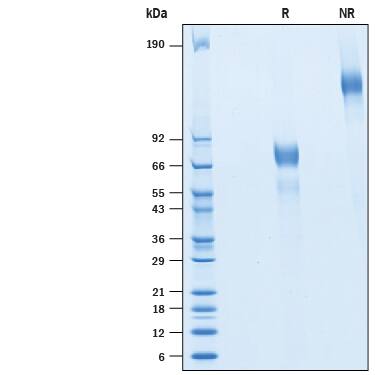Recombinant Human ICAM-4 Fc Chimera Protein, CF
R&D Systems, part of Bio-Techne | Catalog # 10407-IC

Key Product Details
Source
CHO
Accession #
Structure / Form
Disulfide-linked homodimer
Conjugate
Unconjugated
Applications
Bioactivity
Product Specifications
Source
Chinese Hamster Ovary cell line, CHO-derived human ICAM-4 protein
| Human ICAM-4 (Ala31-Ala240) Accession # Q14773.1 |
DIEGRMD | Human IgG1 (Pro100-Lys330) |
| N-terminus | C-terminus |
Purity
>95%, by SDS-PAGE visualized with Silver Staining and quantitative densitometry by Coomassie® Blue Staining.
Endotoxin Level
<0.10 EU per 1 μg of the protein by the LAL method.
N-terminal Sequence Analysis
Ala31
Predicted Molecular Mass
50 kDa
SDS-PAGE
50-60 kDa & 70-80 kDa, under reducing conditions
Activity
Measured by its binding ability in a functional ELISA.
When Recombinant Human Integrin alphaL beta2 (Catalog # 3868-AV) is immobilized at 1 µg/mL (100 µL/well), Recombinant Human ICAM-4 Fc Chimera (Catalog # 10407-IC) binds with an ED50 of 0.25-1.5 μg/mL.
When Recombinant Human Integrin alphaL beta2 (Catalog # 3868-AV) is immobilized at 1 µg/mL (100 µL/well), Recombinant Human ICAM-4 Fc Chimera (Catalog # 10407-IC) binds with an ED50 of 0.25-1.5 μg/mL.
Scientific Data Images for Recombinant Human ICAM-4 Fc Chimera Protein, CF
Recombinant Human ICAM-4 Fc Chimera Protein SDS-PAGE
2 μg/lane of Recombinant Human ICAM-4 Fc Chimera (Catalog # 10407-IC) was resolved with SDS-PAGE under reducing (R) and non-reducing (NR) conditions and visualized by Coomassie® Blue staining, showing bands at 50-60 kDa & 70-80 kDa, and 140-160 kDa, respectively.Formulation, Preparation and Storage
10407-IC
| Formulation | Lyophilized from a 0.2 μm filtered solution in PBS with Trehalose. |
| Reconstitution | Reconstitute at 400 μg/mL in PBS. |
| Shipping | The product is shipped at ambient temperature. Upon receipt, store it immediately at the temperature recommended below. |
| Stability & Storage | Use a manual defrost freezer and avoid repeated freeze-thaw cycles.
|
Background: ICAM-4
References
- Gahmberg, C.G. et al. (1997) Eur. J. Biochem. 245, 215.
- Lee, G. et al. (2003) Blood 101:1790.
- Southcott, M.J.G. et al. (1999) Blood 93:4425.
- Spring, F.A. et al. (2001) Blood. 98:458.
- Hermand, P. et al. (2003) J Biol Chem. 278:4892.
- Kaul, D.K. et al. (2006) Am J Physiol Cell Physiol. 291:C922.
- Ihanus, E. et al. (2007) Blood 109:802.
Long Name
Intercellular Adhesion Molecule 4
Alternate Names
CD242, ICAM4
Gene Symbol
ICAM4
UniProt
Additional ICAM-4 Products
Product Documents for Recombinant Human ICAM-4 Fc Chimera Protein, CF
Product Specific Notices for Recombinant Human ICAM-4 Fc Chimera Protein, CF
For research use only
